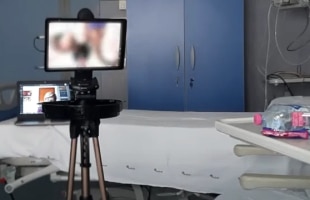- Coronavirus, makers help to create 3D valves for the Chiari hospital
- Italian 'makers' working for hospitals and the Red Cross
- Maker Faire: the coronavirus does not stop the 2020 edition
Share
by Celia Guimaraes April 26, 2020 A robotic vacuum cleaner, an auction, an iPad. With these three elements they built the hardware, while the software was made available free of charge by researchers from the Italian Institute of Technology of Genoa and University of Pisa. Thus was born the Lhf-Connect project, a low-cost robot for the coronavirus emergency.Lhf-Connect is a project available to healthcare facilities with instructions for building a telepresence robot. It is an avatar robot, guided thanks to the open source software developed by the IIT research team in collaboration with the University of Pisa, also available on the TechForCare platform of the Institute for Robotics and Intelligent Machines (I-Rim) and Maker Faire Rome .
"Our project, being tested in three hospitals, is called" Low Hanging Fruits "(Lhf) to underline the importance of the effects of robotic research carried out in the last decades which allows us, today, to be able to develop rapid and effective solutions to make up for to emergency and unexpected situations, "explain the IIT experts. They are, in fact, its 'easiest fruits to pick'.
Robotic telepresence avatars are devices that can help patients, perhaps in isolation for weeks, to contact their relatives without exposing the healthcare staff and loved ones to risk: it can move between rooms without direct contact between the patient and the staff. To assemble it, independently and in a few days, using commercially available devices, at a cost that is around a thousand euros.
The first three robots are already working at the Pisan Hospital-University, the USL Tuscany Northwest of Massa-Carrara and the Asfarm Elderly Multipurpose Center of Induno Olona, in the Varese area.
The robotic spot dog
The Brigham and Women's Hospital in Boston is starting to use a robot well known among technology lovers: the spot dog, an industrial product of Boston Dynamics, who now becomes a hospital assistant for the coronavirus emergency.
The American hospital uses the robot, suitably modified with the collaboration of the MIT, the Massachusetts Institute of Technology in Boston, for the first phase of triage of patients suspected of having less serious cases of the virus: with an iPad, the doctor interviews remotely the possible infected; it is hoped that Spot will limit the exposure of healthcare professionals to coronavirus.
Spot is also in Singapore, in the new Changi isolation center, where each room has blood pressure monitors and other medical equipment for remote health checks three times a day, while robots bring meals and provide teleconferencing services to reduce contacts between patients and operators. Authorities are now testing the Boston Dynamics robotic dog at the facility to deliver medicine to patients or measure its temperature.
Artificial intelligence in the ward
Robot capable of sorting patients, analysis of radiographs with the use of artificial intelligence, decoding of the viral genome, vaccine research: the coronavirus pandemic has triggered a virtuous process also in Tunisia, where the services public health is being strengthened by technology. While in the UK, at Royal Bolton Hospital, managed by the National Health Service (NHS), patients often had to wait over six hours before a specialist picked up their x-rays. Now, an initial evaluation of the radiographs is done by software based on artificial intelligence.
Many hospitals around the world are adopting innovative technologies for the first time, from robots to artificial intelligence, due to staff shortages and tenfold workload for the pandemic. A new opportunity for dozens of companies and startups, which develop or renew existing products. But also for the maker community, which works together with open source projects and makes them available to everyone for free.

